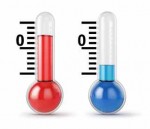1. Don’t over bake
Th is is perhaps the most common cause of cakes that are too dry. Always use a timer – it’s way too easy to be distracted. Stick to the baking time recommended in the recipe but check it 10 minutes before it’s supposed to be finished to make sure everything is on track. If everything is progressing nicely, pop it back in the oven.
is is perhaps the most common cause of cakes that are too dry. Always use a timer – it’s way too easy to be distracted. Stick to the baking time recommended in the recipe but check it 10 minutes before it’s supposed to be finished to make sure everything is on track. If everything is progressing nicely, pop it back in the oven.
At five minutes before it’s supposed to be finished, do a skewer test* to check if it’s done. If not, pop it back in and check again in 5 minute intervals until you’re happy.
2. How hot is your oven? Really?
I’m sorry to be the one to tell you this, but your oven has been lying to you. It’s not 180˚C after all (but you suspected this all along didn’t you). Buy an oven thermometer and test its real temperature. If your oven is running too hot your cakes will be dry. You will need to accommodate this higher temperature by reducing the your dial temperature. You may also need to adjust things like baking time, over tray placement or incorporating more fat or acids into your cake batters.
 3. Milk? Try replacing some or all of it with buttermilk, yogurt or sour cream.
3. Milk? Try replacing some or all of it with buttermilk, yogurt or sour cream.
Buttermilk, yoghurt and sour cream are acidic ingredients. The acidity helps to tenderize the gluten in cake batter and prevent the formation of proteins. These ingredients also have higher fat contents which also imparts more moisture to a cake. Using these ingredients over normal milk will give you a softer, moister, more tender cake texture.
If you don’t have bought buttermilk available you can make your own by adding 1 tablespoon of white vinegar or lemon juice with 1 cup of milk. Let the milk sit until it curdles (approx 10 minutes).
4. Use a sugar solution on the baked cake.
Most tips for baking moist cakes focus on the ingredients and baking process. What happens when you’re cake is baked and you have a sneaking suspicion that it’s not as moist as you’d hoped.
Well, before you turn your cake into trifle (which is always a good option to rescue a dry cake – see below), try mixing a sugared water solution (1 cup sugar to 2 cups water) and popping it in a spray bottle. Poke a few holes in your baked cake and lightly mist the cake with the sugar water. Allow the mist to soak in and repeat as necessary. Only mist the cakes lightly though, you don’t want them too wet.
5. Put the still hot cake into the freezer
As odd as it may sound, giving your freshly baked, still hot cake, a 30 minutes session in your freezer helps it to condense into an extremely moist and tender texture.
When just out of the oven, remove the cake from the pan and place both cake and the parchment it was baked in, on a rack and then straight into the freezer. Of course the heat from the cake may affect other items in your freezer so be aware of this.
But if everything fails, and your cakes are still on the dry side, declare yourself a Trifle Queen (or King).
Add some fruit, berries, syrup, custard, cream, mascarpone, nuts, liqueur or what ever takes your fancy. No shame in that! There’s a reason trifles are a classic recipe that have been around since days of old – they are utterly delicious, super easy to make and have been the savior of many a dry cake.
*The Skewer test – To check whether a cake is cooked, insert a toothpick or skewer into the centre of the cake. It should pull out clean with only a few crumbs clinging to it.
If you can still see any gooey batter on the toothpick it’s not ready. Put it back in the oven.
Next time you test it with the toothpick, don’t stick it down the same hole, make a new hole – the first one you used is no longer an accurate indicator of whether the cake is done.






Super tips….thanks!! 🙂
Pleased these tips helped Chitra.
Hi Annette
Depends what type of cake it was. Here are some suggestions:
1.Try adding a flavoured sugar syrup. Lemon or orange is good. You could also then add a citrus glaze to increase the sweetness.
2. A liqueur based syrup also adds a lot of flavor.
3. You could pour sweetened condensed or evaporated milk over the cake (you might want to gently heat the cake to increase absorption of the milk).
4. You can also turn cake into tiramisu or trifle – adding cream, fruits, jelly, syrups and liqueurs.
5. There are always cake pops too – turning the cake into crumbs and adding frosting, before reshaping the cake into balls.
6. Add pieces of cake and nuts, fruits, chocolate etc to some ice-cream and make an ice-cream cake.
Any tips on keeping an ice cream cake somewhat moist after being in the freezer?
And if ever using a box cake (which I never do… Unless I need a fast cake for a function) always replace the oil with yoghurt.
If the recipe calls for 1 cup of milk do I put 1 cup of yogurt?
I replace oils, if you are replacing milk I would add yoghurt till the consistency is similar to cake (thinner than a brownie mix) and check the time but it would absolutely work.
Completely agree – aim for the same consistency as normal cake batter. You need to trust your instincts with baking. Yes it is science – but there’s an element of art (and experimentation) about it too.